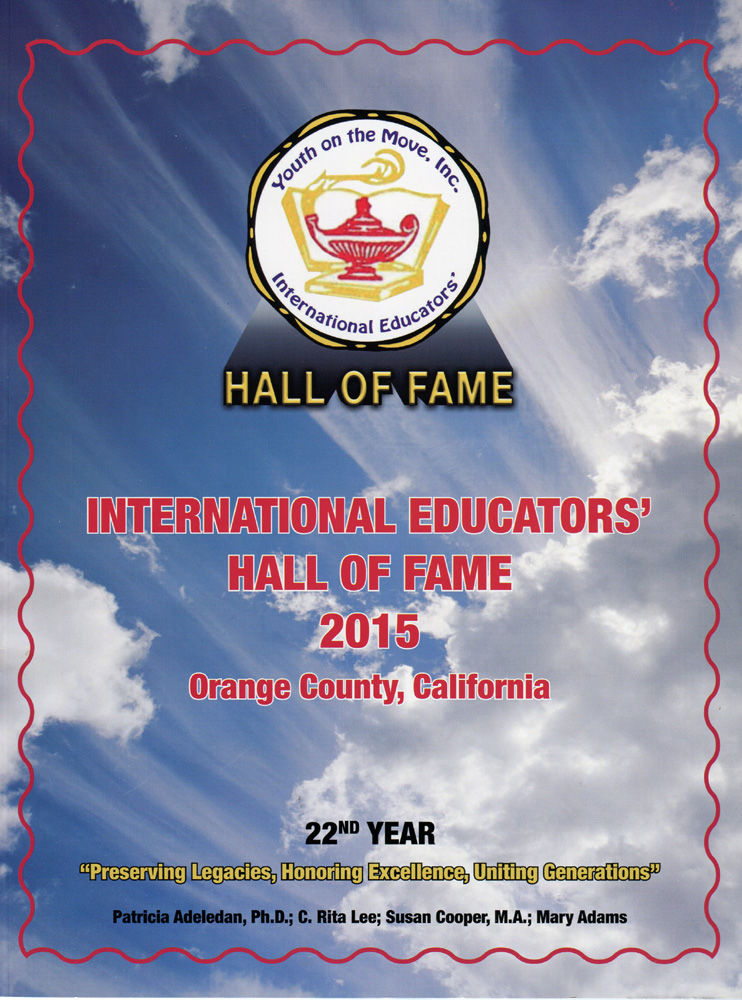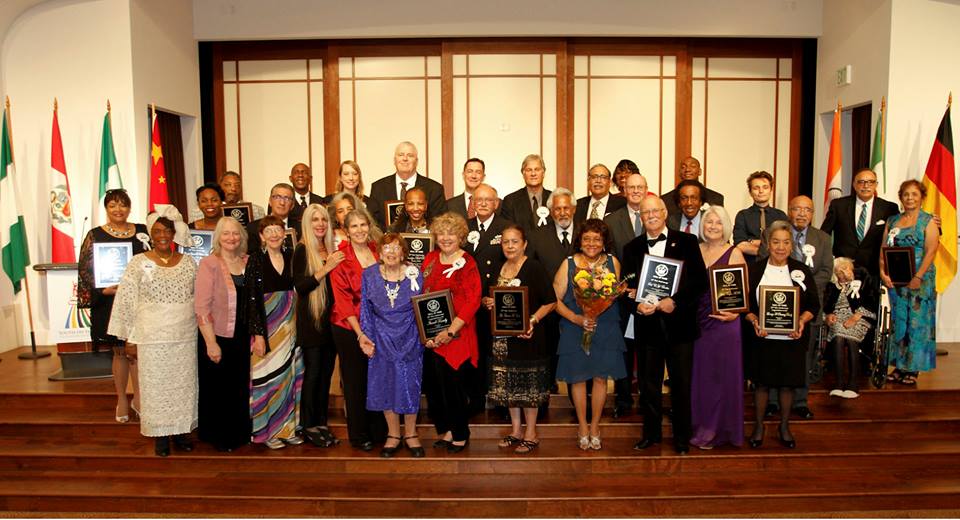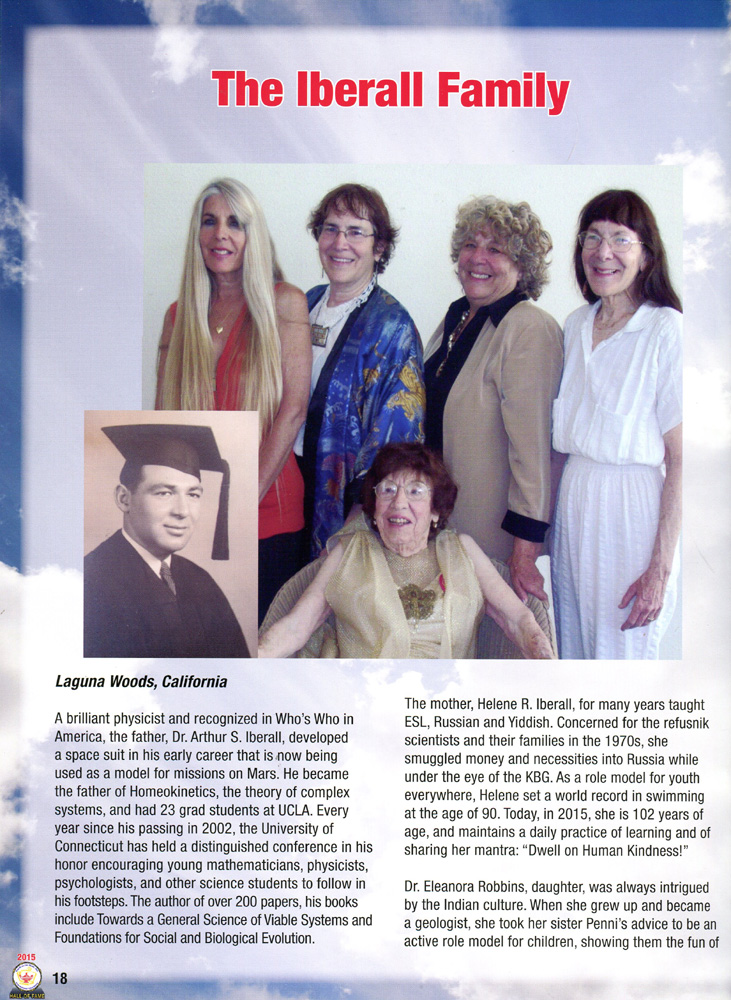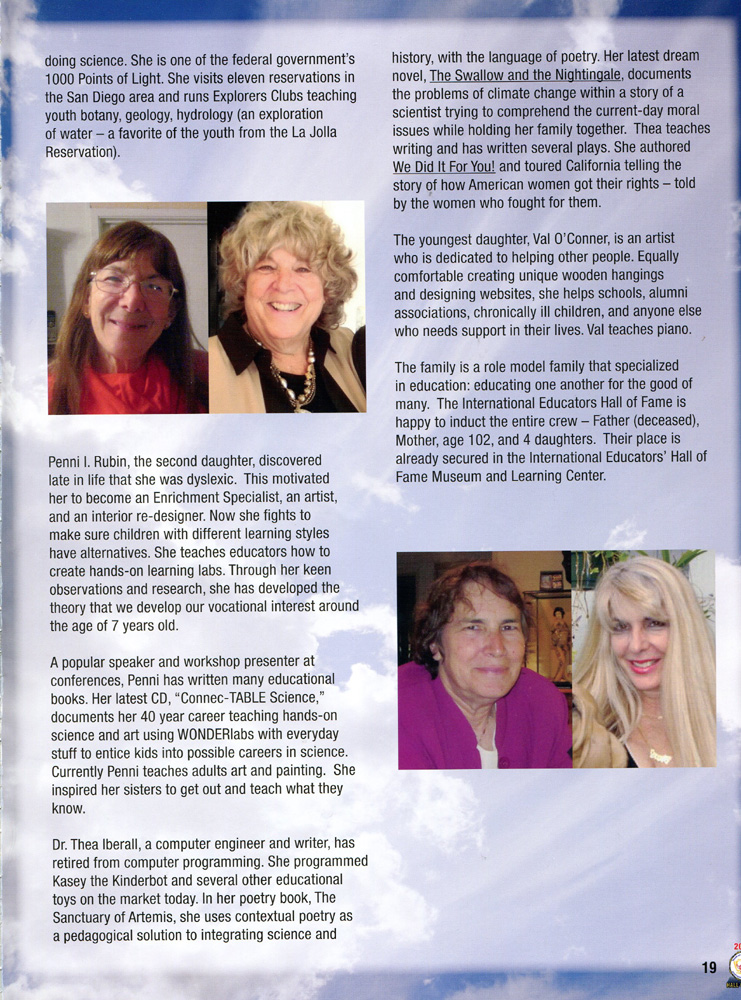Parents, three sisters join her
with education honor
BY GARY WARTH
SAN DIEGO
A nonprofit that usually recognizes individual careers in education
recently broke with tradition by inducting the entire family of a San
Diego State University adjunct professor into a hall of fame.
Youth on the Move International Educators’ Hall of Fame has recognized
about 620 people from 30 countries since its creation in 1992. Last
month the hall added Eleanora Robbins of SDSU; her sisters Penni Rubin,
Thea Iberall and Val O’Connor; their 102-year-old mother, Helene Iberall;
and their late father, Arthur Iberall.
“It was just amazing,” Robbins said about the ceremony, which included a
red carpet entrance in an Orange County ceremony Oct. 24.
The hall recognizes a variety of educators, and recently expanded to
include law enforcement and members of the military who are known as
teachers in their field. Honorees must be either retired or have worked
more than 20 years, and are judged by criteria that includes work they
do beyond their jobs and personal challenges, such as their own learning
disabilities, that they’ve overcome.
Iberall family members were not all classroom teachers, they all were
educators in their own way, and their combined resumes reads almost like
a fanciful movie script.
The patriarch, Arthur Iberall, was a physicist who developed a concept
being used in the design of a space suit for
missions to Mars. His wife, Helene, taught English to Russian
immigrants, once smuggled letters from dissidents out of the Soviet
Union and holds a world swimming record for people 90 and older.
Robbins served in the Peace Corps and teaches
geology to children on local Indian reservations. Thea Iberall is an
author and playwright, O’Connor is an artist and musician, and Rubin
is an artist and musician who has dyslexia and founded a school to
help students who have different ways of learning.
“They’re role models,” said Pat Adelekan, founder
and CEO of Youth on the Move. “And what better example of role models
than a family who has given their lives to education?” Arthur Iberall
was a pioneer in homeokinetics, a branch of physics he developed with
two other physicists in the 1970s. The concept treats all complex
systems on an equal footing, providing them with a common viewpoint
and language.
While standard physics study systems at separate
levels— atomic, nuclear, biophysics and others— homeokinetic physics
study the processes that bind the different levels, with a basic
premise that the entire universe consists of atomisticlike units bound
in interactive ensembles to form systems.
In the 1940s, Iberall developed the concept of
lines of non-extension in the human body. The theory that there are
lines on the body that don’t stretch or contract during body movement
was used in a space activity suit developed by NASA and the Air Force
in the 1950s. Although that suit was never put in use, the concept is
the basis of a new form-fitting space suit being developed by
researchers at the Massachusetts Institute of Technology for possible
trips to Mars. After his death in 2002, the University of Connecticut
created a conference in his honor to encourage young mathematicians,
physicists, psychologists and other science students to follow in his
footsteps. Besides being a brilliant physicist who wrote more than 200
papers, Iberall also was a natural teacher, Robbins said about her
father, who was a visiting scholar at UCLA after moving to California
in the 1980s. Helene Iberall was in some ways a conventional mother,
helping out at her daughters’ schools and leading a Camp Fire Girls
troop, but she also has been a passionate advocate for certain causes
and has gone to extreme levels to help others.
Robbins said when her sister Thea came out as gay,
her mother talked to neighbors and gave lectures about tolerance in
Philadelphia, where they were living at the time. After moving to a
retirement community in California, she taught English and Yiddish to
Russian immigrants. As an active swimmer in her retirement community,
she also set a swimming record for people 90 years old. Robbins, 73,
said her mother surprised her with a daring move during a trip to the
Soviet Union in the 1970s. The two were accompanying Robbins’ husband,
Brian, who went to Moscow as part of studies on rats and bats he was
doing for the Smithsonian.
“She got hold of the American Jewish Congress —
she was a board member — and said, ‘Who needs to be visited and what
should I take?’” Robbins said about her mother’s plans before the
trip.
Helene Iberall collected books, letters and money
from Americans to take to their friends and relatives in Moscow, then
loaded her suitcase with letters from the Russians to bring to the
U.S. Among the letters was one from Israeli politician and writer
Natan Sharansky, who would spend nine years in Soviet prisons.
As for her own career, Robbins said her interest
in geology began while picking up fossils near a creek on walks with
her father in Washington, D.C., where she was born.
After earning her degree, Robbins joined the Peace
Corps and helped in geological surveys in Tanzania.
“Coming from my family, volunteering was something
normal,” she said about the experience, which included playing
American folk songs on her guitar with local children.
She worked for the U.S. Geological Survey through
seven presidential administrations, and for 11 years taught outdoor
science to inner-city children in Washington, D.C., in a program that
earned a “Thousand Points of Light” recognition for volunteerism.
After she retired and moved with her husband to San Diego in 2001,
Robbins became an adjunct professor at SDSU and continued her outreach
by teaching geology at 11 Indian reservations. She since has cut back
to teaching monthly at six.
Thea Iberall, 66, a computer engineer and writer,
has a Ph.D. in computational neuroscience from the University of
Massachusetts and taught at the Hartford Graduate Center in
Connecticut. She also has a master’s degree in writing from the
University of Southern California, where she was a research faculty
member until leaving to focus on writing in 2001. “People in my family
don’t really retire,” she said from her home in Massachusetts.
An award-winning writer with more than 50
published poems, she combined her scientific training with language to
develop a style called contextual poetry, as explained in her website.
“I combine some of my father’s theories of complex
systems with mythology and how the patriarchy is destroying us,” she
said.
Her play, “We Did it For You,” toured from San
Diego to San Francisco, and she wrote the children’s musical “At
Seven” with her sister Rubin, 70. The subject of the play was based on
Rubin’s research and theory that people develop their vocational
interest around age 7. Discovering that she was dyslexic as an adult,
Rubin has worked at helping children overcome learning challenges and
has written many educational books. She was the educational supervisor
at the Cleveland Children’s Museum and now teaches art and painting to
adults while taking care of her mother in Laguna Woods. Her sister
O’Connor, 64, lives in Davie, Fla., and teaches children piano, which
she and all her sisters play. O’Connor also does work to help schools,
alumni associations, chronically ill children and others. Adelekan
said she got the idea for a hall of fame for educators while watching
an induction ceremony for an athletic hall of fame. “I was thinking,
‘Educators need that,’” she said.
gary.warth@sduniontribune.com
SDSU adjunct professor Eleanora Robbins has been
inducted into the Youth on the Move International Educators’ Hall of
Fame.
Eleanora Robbins
tutors children at the Barona Reservation and teaches monthly at six
reservations.
MISAEL VIRGEN
U-T




